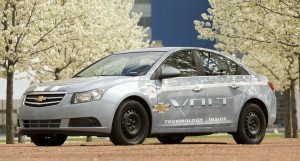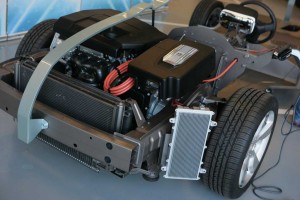
Is Volt really an electric vehicle or just a gussied-up hybrid? New questions have been raised about the ways its drivetrain operates.
With the Chevrolet Volt making its official launch this week, General Motors has found itself in the midst of a potentially serious controversy over the precise way the so-called extended-range electric vehicle actually operates – and whether the maker has been honest about its limitations.
To some, GM has engaged in a Watergate-style cover-up, and that message could resonate with those who still call the company “Government Motors.” To others, however, it’s little more than a tempest in the proverbial teapot and, if anything, just proves that GM is making sure that whatever it takes Volt will live up to its loftiest expectations.
In a Monday news release, GM declared Volt “Reinvents Automotive Transportation.” There’s little question that the new model is a significant improvement over the current crop of hybrid-electric vehicles, like the Toyota Prius, which can operate under battery for very limited distances at low speeds.
As first conceived, Volt was designed to run exclusively on battery power. Its 16 kilowatt-hours of lithium-ion batteries were intended to give the vehicle about 40 miles range solely in electric mode and at speeds of up to more than 90 mph.
But as the “E-REV” gets ready to launch a few key things have changed. For one thing, GM now claims that Volt’s battery-only range is more accurately somewhere between 25 and 50 miles, depending upon road and weather conditions and individual driving patterns.
But the real controversy concerns the way the underlying drive system actually operates.
Unlike a conventional battery-electric vehicle, or BEV, Volt has the ability to keep running even after its batteries ran down. The secret is a small inline-four-cylinder gasoline engine that automatically fires up once the battery charge ran down. As conceived, this so-called “serial hybrid” design uses the gas engine only to generate electricity to power Volt’s electric motors.
But that’s not entirely accurate, it turns out, for those who take a close look at the patent GM received on September 21st. In an effort to improve operating efficiencies – meaning both maximum range and performance – some modest changes were made to the 4ET50, electric drive unit that’s the heart of what GM has dubbed the Voltec propulsion system.
A perusal of notes I have personally taken over the nearly three years since the concept Volt was first revealed – and the stories I have personally written or archived from other sources – clearly indicate that at no time would the gasoline motor on Volt ever provide direct power to the vehicle’s wheels.
In fact, there are conditions where that can happen, acknowledges Volt’s program chief, Tony Posawatz.
To be clear, he told TheDetroitBureau.com during a lengthy interview, under the vast majority of circumstances, Volt “can only run with the traction (electric) motors.”
But there are some situations where the strategy has shifted. This occurs only when the batteries have run down and the vehicle is operating in so-called “extended-range mode.”.
These are high-demand “very rare circumstances,” when you’re “running about 70 mph and you tip in” to pass, says Posawatz, or where a fully-loaded Volt is trying to accelerate up a long, steep hill.
In such a situation, the complex set of gears and clutches in the 4ET50 will draw what the GM executive describes as “a small amount” of power directly from the I-4. In other words, some of the gas engine’s torque will be added to the power of the electric motors to handle the load and, Poswatz stresses, to help improve the overall efficiency of the Voltec drive system.
That’s not unlike what happens with a regular hybrid, like Prius, though Posawatz insists it happens far less frequently and, most importantly, that the electric motors are always operating and providing the vast majority of torque under all circumstances. There is never a situation where the wheels are driven directly by the I-4 engine alone.
Nonetheless, in an angry denunciation, Edmunds.com sums it up by declaring, “Frankly, we were lied to.”
Is that a fair characterization? No, GM officials contend. For his part, Posawatz insists, “No program has been as open and transparent on something as far reaching and innovative” as Volt. “We have not fully disclosed the information, I will grant you that,” he says, suggesting that was, in part a strategy while waiting for the patent approval, but Posawatz adds that, “We have not been intentionally deceptive.”
Perhaps not, but the brouhaha raises a number of questions. For one thing: what exactly is the 2011 Chevrolet Volt?
One could now argue that it is just a fancier hybrid, and not a true electric vehicle. Then again, nobody has ever come up with a singularly acceptable definition of an extended-range electric vehicle.
But that could become an issue for those who might now challenge the idea that the Volt should qualify for the government’s $7,500 tax credit, which is also offered to pure battery-electric models, like the Nissan Leaf.
The more important question is how consumers will react. Posawatz and GM’s supporters will say that the modified driveline actually will serve consumers better by ensuring the Chevy Volt can perform as expected under the widest range of operating conditions.
But there’s also the possibility that if this flap gains enough media traction it just might scrape the chrome off the halo Volt was intended to give the long-troubled General Motors. The maker simply doesn’t need the bad publicity just as Volt is getting ready to come to market – and as GM prepares for its long-awaited IPO.


If VOLT needs a small and light Internal Combustion Engine (to provide power to the Electrical System) why not instead of the 4-cylinder of the GM, a single-cylinder one, like the OPRE or the PatOP engines at http://www.pattakon.com , which are 1/4 (one fourth) the weight and 1/4 the size, and which are more efficient and, beyond any doubt, much better balanced than any 4-cylinder available in the GM? Installed anywhere in the car, the small full-balanced single-cylinder will operate hardly noticed by the driver.
By the way, the Wankel rotary Range Extender Modules (REM), like those of AVL and of FEV, are presented as having the best NVH (Noise Vibration Harshness) properties.
Yet the pattakon OPRE Range Extender Module has even better NVH properties, because its basis is not only free of any kind of inertia vibrations, but it is also free of any kind of combustion vibrations. Besides, the OPRE REM has way better fuel efficiency and way lower emissions.
Manousos Pattakos
Hi, Manousos,
You raise some interesting questions and point in a direction I bet the industry will follow. Just note the Jaguar C-X75 concept, which was one of the hits of the Paris Motor Show. It uses a pair of super-light microturbines. The concept is sound, conceptually, because they could operate as turbines do best, at a relatively steady speed to maximize efficiency and output — rather than directly driving the wheels, an approach many makers, including GM and Chrysler, long ago found ineffective because turbines don’t like to rev up and down like an IC engine.
My sense is that GM moved for expediency, opting for a range-extender solution relying on technology it knew and could ramp up quickly v opting for an unknown that could’ve failed embarrassingly.
But, as other makers explore the plug-in and E-REV concepts we just might see some intriguing alternatives.
Paul A. Eisenstein
Publisher, TheDetroitBureau.com
Hello Paul.
Huge companies, like GM, Chrysler etc, cannot keep on talking, about concepts for long, because they have all it takes to make, test and put the concept in production.
Compare the endless press releases about the VOLT project of GM with what Fiat and Schaffler-INA did with their MultiAir / UniAir / TwinAir inventions: they came up with the real thing and said simply: “the TwinAir Fiat 500 is today the greenest gasoline-engine car”; and the official tests proved it really is.
Manousos Pattakos
Tests, like statistics, can come up with some interesting, if less than convincing, results. I’ll be curious to see how TwinAir performs once in reasonably widespread use, though I admit the technology appears very, very promising.
Paul E.
“I admit the (TwinAir) technology appears very, very promising”.
If the MultiAir / TwinAir technology proves the greenest (it is in production for a year, yet it is still under development), what will be after a few steps ahead?
For instance, what about making it some 25% cleaner at urban-cycle, with just a slight modification of its camshaft / software?
The PatAir Electro-Hydraulic system (at http://www.pattakon.com/pattakonHydro.htm ) seems as the evolution of the Fiat MultiAir because it can operate not only according the infinite available modes / strategies of the MutliAir, but also according the infinite modes of the “Outgoing Air Control” cycle.
You can always ask Fiat, or an expert, about it.
Manousos Pattakos
Do note an earlier report on TwinAir on TheDetroitBureau.com:
http://www.thedetroitbureau.com/2010/09/ready-for-two-cylinder-cars-fiat-thinks-so/
You can be sure we’ll be following it as the technology debuts and continues to develop.
Paul E.